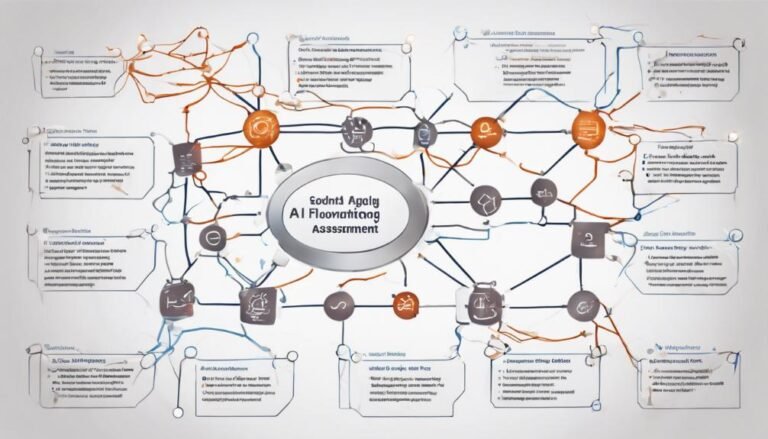AI in Financial Analytics: A Comprehensive Guide
In the domain of financial analytics, the intersection of artificial intelligence presents a landscape of immense possibilities and transformations. From its inception as rule-based systems to the current blend of machine learning, natural language processing, and big data analytics, AI has reshaped the way financial institutions operate and make decisions. As we navigate through the complexities of AI applications in risk management, trading strategies, and customer interactions, a deeper understanding of its implications becomes imperative. The detailed guide on AI in financial analytics serves as a beacon, shedding light on the nuanced advancements and future prospects in this ever-evolving domain.
Key Takeaways
- AI enhances financial model accuracy and risk prediction algorithms.
- NLP enables sentiment analysis and market trend understanding.
- AI-powered risk management optimizes portfolios and mitigates risks effectively.
- AI applications include improved credit scoring, early warning systems, and scenario analysis.
- AI transforms customer experience with personalized insights and AI-driven chatbots.
Evolution of AI in Finance
The evolution of artificial intelligence in the domain of finance has been characterized by a rapid progression from basic automated tasks to sophisticated predictive analytics and machine learning algorithms.
In the historical context of AI in finance, the journey began with rule-based systems used for tasks like fraud detection and algorithmic trading in the 1980s. As technology advanced, AI applications expanded to include natural language processing for sentiment analysis, chatbots for customer service, and personalized investment recommendations.
The turning point came in the early 2000s, with the emergence of machine learning techniques such as neural networks and deep learning. These advancements enabled financial institutions to leverage vast amounts of data for risk assessment, portfolio management, and trading strategies.
Today, AI in finance has reached new heights with the integration of big data analytics, cloud computing, and real-time processing capabilities. This evolution has not only enhanced operational efficiency and decision-making processes but has also paved the way for innovative financial products and services tailored to individual customer needs.
Machine Learning in Financial Modeling
Machine learning plays an essential role in enhancing the accuracy of financial models by enabling sophisticated model accuracy assessment techniques. Additionally, it facilitates the development of robust risk prediction algorithms that are essential for making informed investment decisions in the dynamic financial landscape.
Model Accuracy Assessment
When evaluating model accuracy in financial analytics, the focus is on utilizing quantitative methods to gauge the predictive performance of machine learning algorithms within the context of financial modeling.
Data visualization plays a vital role in model accuracy assessment, allowing analysts to visually inspect the relationship between actual and predicted values, identify patterns, and assess the overall performance of the models. By leveraging advanced visualization techniques, such as scatter plots or residual plots, analysts can gain deeper insights into the predictive capabilities of the models and identify potential areas for improvement.
In the domain of predictive modeling, accuracy assessment is essential to guarantee that the models are reliable and robust enough to make informed decisions in the financial domain. Through rigorous testing and validation processes, analysts can determine the effectiveness of the models in forecasting future trends and making sound financial predictions. Ultimately, accurate model assessment is fundamental in building trust in the predictive capabilities of machine learning algorithms within financial analytics.
Risk Prediction Algorithms
Risk prediction algorithms in financial modeling harness the power of machine learning to quantitatively assess and forecast potential financial risks. These algorithms play a vital role in various aspects of financial decision-making, including credit scoring, fraud detection, market forecasting, and portfolio optimization.
In credit scoring, risk prediction algorithms analyze an individual's credit history, payment behavior, and other relevant factors to determine the likelihood of default on a loan or credit card. By leveraging historical data and patterns, these algorithms provide lenders with valuable insights to make informed lending decisions.
Moreover, in fraud detection, these algorithms help financial institutions identify unusual or suspicious activities by detecting anomalies in transactions and behavior patterns. This proactive approach enables timely intervention to prevent financial losses due to fraudulent activities.
Furthermore, risk prediction algorithms are instrumental in market forecasting by analyzing market trends, historical data, and other variables to predict future asset prices and market movements.
Additionally, in portfolio optimization, these algorithms aid in constructing well-balanced investment portfolios that maximize returns while minimizing risks.
Natural Language Processing (NLP) Applications
The integration of Natural Language Processing (NLP) in financial analytics has opened up new avenues for sentiment analysis, allowing for the extraction of valuable insights from text data.
Entities recognition applications in NLP further enhance the ability to identify and categorize key information, aiding in making more informed decisions within the domain of financial analysis.
These NLP applications not only streamline data processing but also contribute to a more thorough understanding of market trends and sentiments.
Sentiment Analysis in NLP
Financial institutions increasingly rely on sentiment analysis in NLP applications to extract valuable insights from vast amounts of unstructured data, enabling more informed decision-making processes. Sentiment analysis involves the use of algorithms to determine the sentiment expressed in text data, allowing financial institutions to gauge public opinion, market trends, and investor sentiment accurately.
Key aspects of sentiment analysis in NLP for financial analytics include:
- Text Classification: By categorizing text data into positive, negative, or neutral sentiments, financial institutions can better understand customer feedback, market sentiment, and news sentiment.
- Sentiment Scoring: Assigning a numerical score to text data helps quantify sentiment intensity, enabling deeper analysis of trends and patterns.
- Sentiment Analysis Models: Leveraging machine learning models to improve sentiment analysis accuracy and adaptability to changing market conditions.
- Real-time Sentiment Monitoring: Continuous monitoring of sentiment in real-time provides up-to-date insights for timely decision-making in financial markets.
The integration of sentiment analysis in NLP empowers financial institutions to harness the power of language data for strategic decision-making and risk management.
Entity Recognition Applications
Entity recognition applications play a pivotal role in Natural Language Processing (NLP) by enabling the identification and extraction of specific entities such as names, organizations, locations, and financial terms from unstructured text data. In the domain of financial analytics, entity recognition applications are vital for tasks such as sentiment analysis and document classification. By accurately identifying entities within financial documents, these applications can provide valuable insights into market trends, investor sentiment, and company performance.
In sentiment analysis, entity recognition helps in identifying key entities mentioned in texts and associating sentiment towards them, allowing for a deeper understanding of market perceptions and potential investment opportunities.
Additionally, in document classification, entity recognition aids in categorizing financial reports, news articles, and research papers based on the entities mentioned, facilitating easier retrieval and analysis of relevant information for decision-making processes.
AI-Powered Risk Management
Utilizing artificial intelligence for risk management in financial analytics represents a significant advancement in identifying and mitigating potential threats within investment portfolios. AI-powered risk management systems can enhance decision-making processes by providing real-time insights and predictive capabilities.
Here are key ways AI is transforming risk management in finance:
- Enhanced Portfolio Optimization: AI algorithms can analyze vast amounts of data to optimize investment portfolios based on risk-return profiles, market conditions, and investment goals.
- Improved Credit Scoring Models: AI enables more accurate and dynamic credit scoring by incorporating non-traditional data sources, behavioral patterns, and real-time monitoring, leading to better risk assessment.
- Early Warning Systems: AI can detect potential risks and anomalies in financial data, alerting stakeholders to emerging threats before they escalate.
- Scenario Analysis and Stress Testing: AI facilitates complex scenario modeling and stress testing, helping financial institutions assess the impact of various risk factors on their portfolios.
Incorporating AI into risk management processes empowers financial institutions to make more informed decisions, manage risks effectively, and optimize their overall performance.
Automation of Trading Strategies
The integration of artificial intelligence in automating trading strategies has revolutionized the financial industry by enhancing efficiency and precision in executing trades. Algorithmic trading optimization and AI-driven portfolio management have become essential tools for traders looking to gain a competitive edge in the market. These AI-powered solutions analyze vast amounts of data at unparalleled speeds, allowing for the swift identification of profitable trading opportunities and the optimization of trading strategies.
High frequency trading automation, another key aspect of AI in trading, leverages advanced algorithms to execute trades at speeds unattainable by human traders. This automation, combined with AI-powered decision-making processes, enables traders to capitalize on market inefficiencies and make split-second trading decisions with a high degree of accuracy.
Enhancing Customer Experience With AI
AI-driven technologies have greatly transformed the financial industry, particularly in enhancing the overall customer experience. By leveraging AI tools, financial institutions can now provide personalized insights and seamless services to their clients, ultimately leading to higher satisfaction levels and retention rates.
Two key ways in which AI enhances customer experience are:
- Personalized Insights: AI algorithms can analyze vast amounts of data to offer personalized investment recommendations and financial advice tailored to each customer's unique needs and risk tolerance.
- Chatbot Assistance: AI-powered chatbots are available 24/7 to address customer queries, provide account information, and even assist in making transactions, offering a convenient and efficient communication channel for customers.
These AI-driven solutions not only streamline customer interactions but also lead to quicker issue resolutions and more accurate responses, enhancing the overall customer experience in the financial sector.
Future Trends in AI Integration
Advancements in financial analytics are paving the way for future trends in the integration of artificial intelligence, shaping the landscape of customer experience and operational efficiency within the industry. As AI continues to evolve, addressing AI ethics and regulatory challenges becomes essential. Ensuring that AI algorithms are transparent, fair, and unbiased is vital in maintaining trust with customers and regulators.
Moreover, data privacy and security concerns are at the forefront of AI integration. Financial institutions must prioritize safeguarding sensitive information and complying with regulations like GDPR and CCPA. Implementing robust security measures and encryption protocols is imperative to protect customer data from potential breaches or misuse.
Looking ahead, the future of AI integration in financial analytics will likely see a greater emphasis on developing AI systems that not only enhance decision-making processes but also uphold ethical standards and data protection regulations.
Conclusion
To sum up, the integration of AI in financial analytics has unquestionably revolutionized the industry, enhancing accuracy, predicting risks, and optimizing portfolios.
Despite its undeniable benefits, one cannot ignore the potential risks and ethical considerations that come with the reliance on AI in finance.
As we continue to progress in this technological era, it is imperative that we remain vigilant and thoughtful in our approach to AI implementation in financial analytics.







